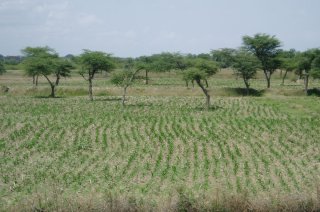
Methodology
The models used are LINPAC (LINtul model for Perennial and Annual Crops) and NARC (Nutrient Application Requirement Calculator).
LINPAC simulates total biomass production, crop yield and the soil water balance of grain maize under irrigated and rain fed conditions, without nutrient limitation and free from pests, diseases and weeds. Results from LINPAC were used as input for NARC to calculate the response of maize to 100 kg N fertilizer ha-1 without additional organic N input, under the condition that the soil N stock is in equilibrium. Jing et al. (2012) and Setiyono et al. (2010) provided values for some key input parameters of both LINPAC and NARC.
Various inputs for LINPAC have been obtained from the following data:
- Soil property maps (5’ resolution raster maps) were obtained from the Digital Soil Map of the World (DSMW) in combination with the soil attribute table of WISE v1.2.
- Weather data (30’ resolution raster maps) of 1991 – 2010 from the Climate Research Unit (CRU).
- Cropland areas and actual average grain maize yields from 1997 – 2003 have been derived from Ramankutty et al. (2008) and Monfreda et al. (2008).
All results are computed per raster cell and illustrated in raster maps (5’ resolution; cell area approx. 86 hectare near the equator). We simulated grain yields (optimally irrigated and rain fed) for each year in the period 1991 – 2010 and compared the average values (n=20) with actual grain yields from 1997 – 2003. We also calculated the lengths of the growing season (expressed as temperature sum) of 1991 – 2010 per raster cell. The median length (n=20) was used to adjust the required temperature sum for maturity of maize in each cell. This assumes that farmers use a maize variety that is adapted to the local conditions and matures on average in time. Annual sowing dates were simulated based on suitable soil moisture and temperature conditions in a predefined sowing window.
In calculating the response of maize to nitrogen fertilizer with NARC we assumed that 10% of the standing crop yield is lost during harvesting, 50% of the aboveground crop residues is harvested and no ammonia volatilizes from applied fertilizer. Harvesting loss, 50% of the crop residues and root biomass remain at the field and are added to the soil.
